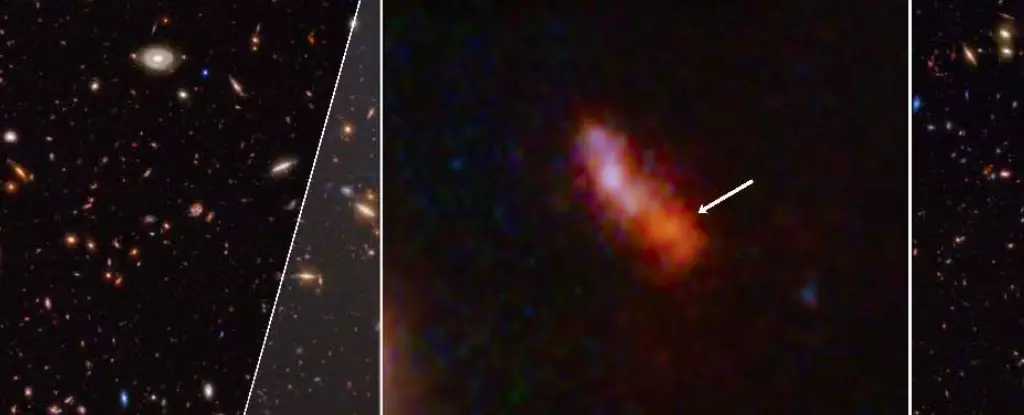The cosmos has always been an arena for revelations, but the James Webb Space Telescope (JWST) has undeniably accelerated our quest for knowledge about the universe’s infancy. The JWST has unveiled not just new galaxies but entire epochs of existence that were once mere speculation. Its latest triumph involves the detection of the most remote galaxy yet, named MoM-z14, which appears to have emitted light a mere 280 million years after the Big Bang. This unprecedented discovery elevates the JWST’s status as a revolutionary instrument in the field of astronomy and cosmic studies.
Prior to the JWST’s launch, our grasp of the early universe was severely limited. Instruments like the Hubble Space Telescope had their merits but were constrained by their smaller mirror sizes, which deterred their ability to capture infrared light from the oldest galaxies. The Spitzer Space Telescope specialized in infrared observation yet fell short with its diminutive 85 cm mirror. Enter the JWST with its expansive 6.5-meter mirror, and it becomes clear why this observational giant has unlocked mysteries that have long eluded our comprehension.
Revolutionizing Our Understanding of Galaxy Formation
The JWST’s mandate centers on understanding galaxy assembly—how galaxies form and evolve over time. As it commenced its observations, the findings were both startling and illuminating. Within a matter of weeks, the telescope revealed a treasure trove of luminous galaxies at extraordinarily high redshifts, particularly those greater than z=10. This newly identified segment of the universe has not merely expanded our observational capabilities but has also ignited discussions about galaxy formation during the early epoch of cosmic history.
The implications of such discoveries cannot be overstated. For instance, the galaxy MoM-z14, identified through the Mirage survey, has challenged existing paradigms concerning the number of galaxies that should exist at such a high redshift. The findings have sparked vital questions about not only the quantity but the quality and nature of these primordial constituents of the universe. The new paper presenting this discovery, titled “A Cosmic Miracle: A Remarkably Luminous Galaxy at zspec = 14.44 Confirmed with JWST,” authored by Rohan Naidu and colleagues, underscores this excitement within the scientific community.
Evidence of a New Cosmic Age
MoM-z14 stands out not merely because of its distance but also due to the fascinating characteristics it exhibits. The analysis revealed that a majority of the galaxy’s light originates from stars rather than from an active galactic nucleus (AGN). This detail hints at the existence of remarkable stellar phenomena in the early universe, possibly including supermassive stars. The study sheds light on their nitrogen-to-carbon ratios, which exceed those found in our own Sun. This chemical fingerprint implies that cosmic processes resemble those seen in ancient globular clusters within the Milky Way, connecting the threads of cosmic evolution and reaffirming theories about how stars formed in those primordial environments.
Astronomers have discerned two distinct morphologies in these early galaxies—point sources and extended formations—which may serve as indicators of their evolutionary pathways. The intriguing connection between morphology and chemical make-up presents a tantalizing mystery that can deepen our understanding of early galaxy formation and evolution.
The Bimodal Connection: Size and Chemistry
As the JWST uncovers more ancient galaxies, researchers are beginning to identify unique classes of objects, including a category of strong nitrogen emitters exemplified by luminous entities dubbed Little Red Dots. MoM-z14 emerges as a key player in this newfound group of nitrogen-enhanced objects, providing newfound insights into a potential size-chemistry relationship affecting galaxies formed over 10 billion years ago.
The research pushes the narrative beyond mere observation; it invites exploration of how these ancient luminaries may connect to our own Milky Way’s historical framework. Questions abound about whether the features seen in MoM-z14 and similar galaxies are signs of a universal mechanism in cosmic formation and evolution.
Toward the Next Frontier of Cosmic Exploration
The JWST’s impressive capabilities have not only enriched our understanding of the past but have opened the door to an array of future discoveries. The anticipation of findings from the Roman Space Telescope adds further excitement to the scientific community. By surveying an even broader cosmic landscape, researchers hope to confirm or expand upon the groundbreaking results yielded by the JWST.
The ongoing expedition into the cosmos initiated by the JWST serves as a reminder of the mysteries still veiled within the depths of space. With its capacity to unveil worlds unimagined, the telescope stands at the forefront of a transformative era in astrophysics. Indeed, as we delve deeper into the universe’s origins, the JWST elevates the study of cosmic evolution to levels previously thought unattainable, inspiring generations of astronomers eager to unlock the stories of our universe.


Leave a Reply